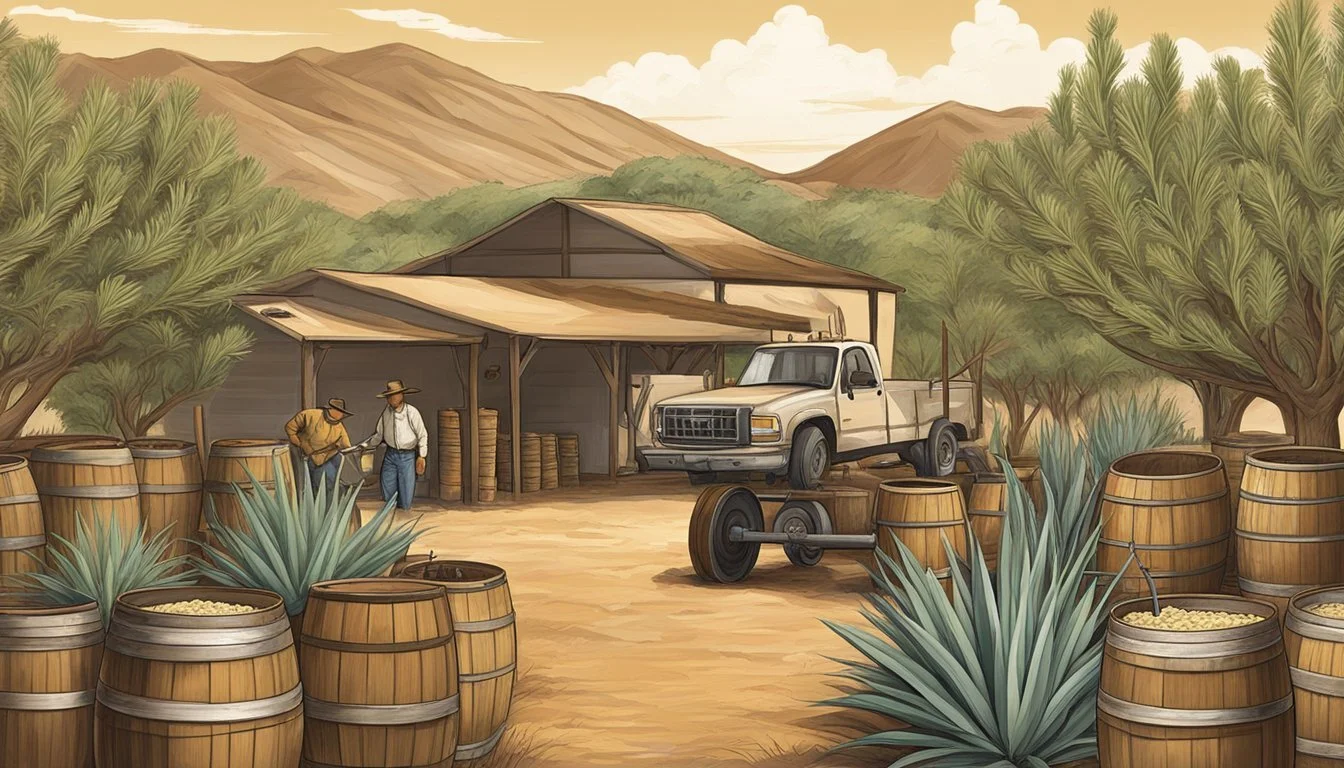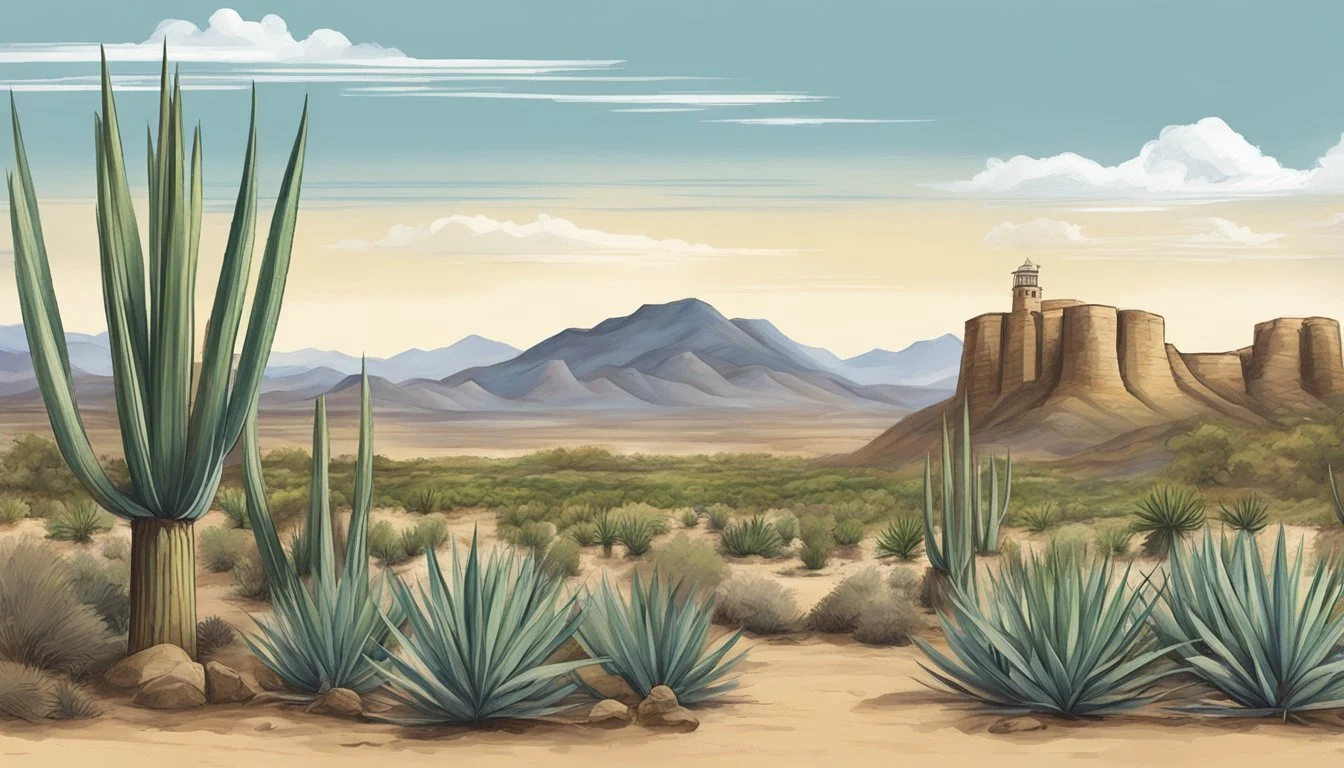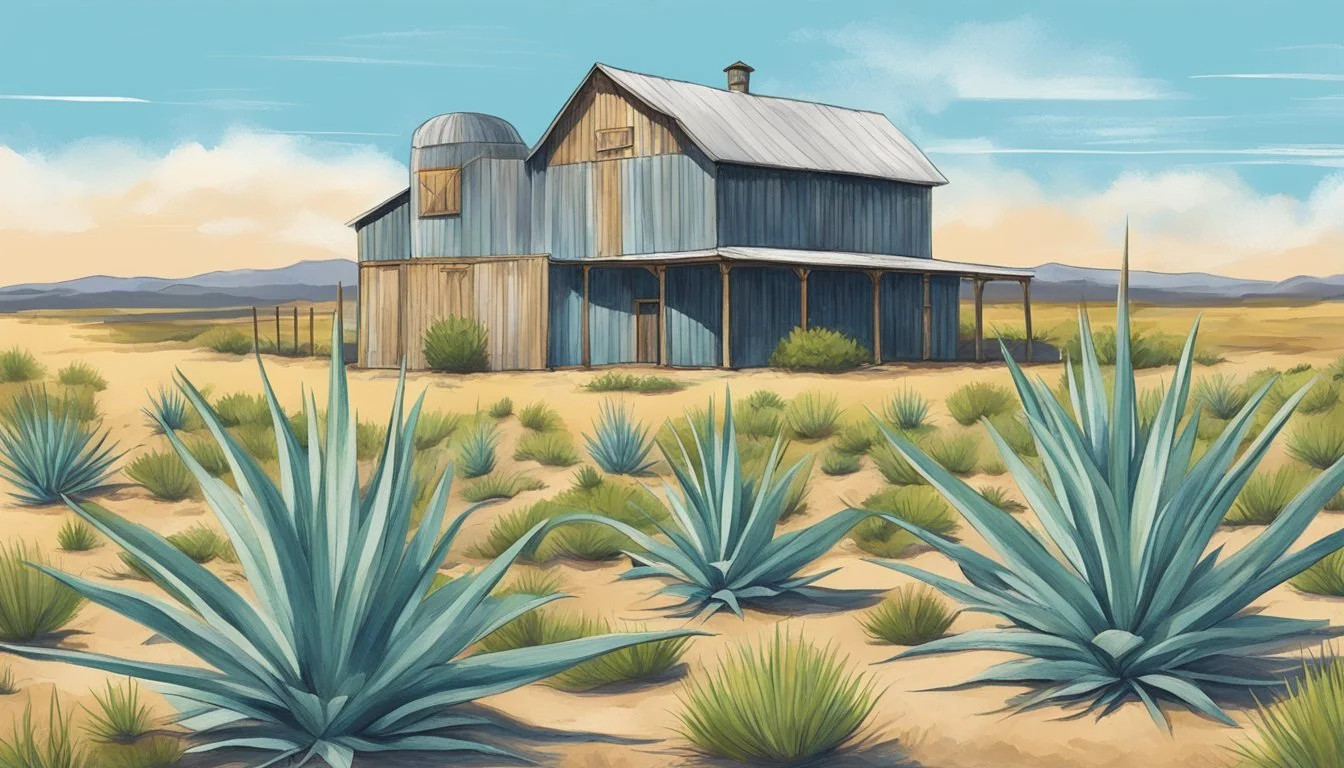Unveiling the Secrets of Sotol
Discovering the Unique Texas Spirit
Sotol, a distilled spirit with deep roots in the Chihuahuan Desert, bridges the gap between Mexican tradition and Texas innovation. Despite being lesser-known than its cousins, tequila and mezcal, sotol possesses a unique profile that reflects the terroir of the region where it is cultivated. It is derived from the Dasylirion plant, commonly referred to as the Desert Spoon or Sotol, which is found in northern Mexico, Texas, and New Mexico.
The spirit has a storied history, with its use dating back to the indigenous peoples of the region, long before the Spanish introduced distillation. Today, sotol is experiencing a renaissance, particularly in Texas, where it is being embraced as part of the state's cultural heritage and crafted with a blend of traditional and modern distillation methods. Desert Door Distillery, established in 2017, stands as a prominent sotol producer in the United States, signaling the spirit's burgeoning popularity.
The rise of sotol in the American craft spirits market signals a shift in consumer tastes toward unique, artisanal products. As sotol garners attention, enthusiasts savor its wide range of flavors, from floral and citrus notes to hints of vanilla, depending on the production process and the specific species of Dasylirion used. This burgeoning interest in sotol opens the doors for more distilleries to explore the potential of this versatile spirit, showcasing the nuanced tastes of the Texas desert.
The History and Origins of Sotol
Sotol, with its intricate history and distinct presence in the Chihuahuan Desert, offers a rich tapestry of cultural significance and a growing popularity in the modern era. This Texas and Chihuahua hallmark stands out for its unique production process and historical importance.
Ancestral Roots and Cultural Significance
Sotol, known scientifically as Dasylirion wheeleri, holds deep roots in the cultural history of the indigenous peoples of Northern Mexico and the Southwestern United States. Historically, it's been used for at least 800 years, with evidence suggesting that the original inhabitants of the Chihuahua region consumed sotol for its psychoactive properties. The significance of sotol goes beyond mere consumption; it's interwoven with spiritual and daily practices, depicting its crucial role in rituals and as a symbol of regional identity.
Sotol Vs. Tequila and Mezcal
While often compared with its cousins, tequila and mezcal, sotol boasts a distinct identity. Unlike tequila, which is made from blue agave, and mezcal, which can be made from over 30 types of agave, sotol is produced exclusively from the sotol plant. Each plant takes around 15 years to mature in the arid climate of the Chihuahuan Desert. The sotol denomination of origin is recognized in Chihuahua, Coahuila, and Durango, providing a clear geographic indicator of its exclusivity to these regions.
Tequila: Made from blue agave; primarily produced in Jalisco, Mexico.
Mezcal: Made from over 30 types of agave; produced in multiple regions.
Sotol: Made from the sotol plant; production region includes parts of Texas, Chihuahua, Coahuila, and Durango.
Rediscovery and Renaissance in Modern Spirits
The 20th century marked a challenging era for sotol, facing numerous bans and restrictions by the Mexican government during the Prohibition period. However, the spirit has undergone a resurgence in recent years. Artisanal producers from both Mexico and Texas are reconnecting with their heritage and have begun to revitalize sotol, capitalizing on the growing global demand for handcrafted and authentic spirits. They emphasize traditional production methods, fostering a renaissance that positions sotol as a premium and culturally significant beverage on the international stage.
Botanical Profile of the Sotol Plant
Sotol, often associated with the spirit distilled from its core, is a plant with a rich botanical and cultural background. Understanding its taxonomy and interaction with the environment is essential to appreciating the nuances of the beverage.
Dasylirion: The Desert Spoon
Dasylirion, also known as the Desert Spoon or Sotol, belongs to the Asparagaceae family, once classified under Liliaceae. This genus includes various species like Dasylirion texanum and Dasylirion wheeleri, among others, not to be confused with agave, to which they are related but distinctly different. The common characteristic is the long, spiny leaves that form a rosette pattern, contributing to its descriptive nickname and distinguishing it from other desert flora.
Notable Species:
Dasylirion wheeleri, found in western Texas to southern Arizona;
Dasylirion texanum, endemic to Texas, known for its drought tolerance.
The plants are dioecious, with separate male and female plants, and only the female plants produce seeds that can be germinated.
Terroir and Its Impact on Sotol
The concept of terroir is crucial in understanding the growth and quality of Dasylirion plants, infusing unique characteristics into the Sotol spirit. Terroir refers to the complete natural environment in which a particular plant is grown, encompassing soil, climate, and the broader ecosystem.
Influences:
Soil: Rocky, gypsum-laced hillsides;
Climate: Arid conditions of the Chihuahuan desert;
Elevation: Ranges from 3,000′ to 6,000′ above sea level.
These conditions not only foster the growth of a robust and resilient Dasylirion but also contribute to the distinct taste profile of the sotol spirit derived from these plants. Such environmental factors make the sotol plant, particularly the species thriving in the Chihuahuan desert, unique expressions of their native landscape.
Production Process of Sotol
The production process of Sotol is a meticulous tradition, deeply rooted in the culture of northern Mexico and the Texan desert, involving harvesting the wild sotol plants, precise fermentation and distillation techniques, and careful aging to create its distinct flavor profiles.
Harvesting the Plants
Harvesters, known as sotoleros, meticulously select and wild-harvest the mature sotol plants by hand. Only the core of the plant, called the piña, is taken, as it contains the sugars needed for fermentation. The plant reaches maturity after approximately 15 years, and it is crucial to the quality of the spirit that only mature plants are harvested.
Fermentation and Distillation Techniques
Once harvested, the piñas are roasted in pits using local firewood, which imparts regional flavors to the sotol. The roasted cores are then crushed and combined with water in a fermentation tank. Wild yeast or added cultures initiate the fermentation process, transforming the sugars into alcohol. This fermented mash is then distilled in either copper or stainless steel stills, carefully monitoring the temperature to ensure the purest essence of sotol is extracted.
Aging and Varieties
Sotol can be consumed young or aged in barrels. The aging process takes place in oak barrels, which can impart a range of flavors from subtle notes to bold profiles, depending on the duration of aging. Sotol varies in type:
Blanco: clear and unaged, offering a direct expression of the sotol plant
Reposado: aged in oak barrels for several months, providing a smoother taste
Añejo: aged for a significant period, possibly years, allowing for a more complex flavor profile
The variations in the distillation and aging process of Sotol contribute to a spectrum of flavors, from the earthy and herbaceous tones of a young spirit to the rich, caramel notes of a well-aged bottle.
The Unique Taste of Sotol
Distinct from other spirits, the flavor of Sotol is intricate, with a rich heritage that has been savored in Texas and Mexico. It strikes a fine balance with its varied flavor notes and offers aficionados an array of aged variations that are as complex as they are delightful.
Flavor Profile and Comparison with Other Spirits
Sotol possesses a nuanced flavor profile that sets it apart from its Mexican cousins, tequila, and mezcal. The spirit is derived from the Dasylirion wheeleri plant, and each sip unfurls layers of complexity. Fruity and citrus notes, such as lime juice and grapefruit, are often prominent, typically followed by a subtle but distinct spiciness. Sotol enthusiasts may also detect hints of pepper and a whisper of cinnamon. Meanwhile, the herbaceous heart of Sotol can evoke comparisons to pine and oak. Unlike tequila's often sweet and agave-forward profile or mezcal's renowned smokiness, Sotol is more earthy, offering a unique spectrum of flavors.
Primary flavors: Citrus, Pepper, Oak, Pine
Common cocktail ingredients: Lime juice, Grapefruit
Aged Sotol: Reposado and Añejo
When Sotol is aged, it reveals additional layers of taste. Reposado Sotol, resting in oak barrels for several months, acquires a warm, golden hue and an intricate palette. The oak imparts a smooth finish, with the initial bright and herbaceous notes giving way to a deeper, more nuanced profile that may include hints of vanilla and caramel.
Añejo Sotol, aged even longer, is characterized by its rich oaken character, where the spirit's inherent flavors are further matured. This aging process lends the Añejo Sotol a boldness that can command the palate with a robust and lingering taste, often enjoyed by those who appreciate the complexity of a well-aged spirit.
Reposado: Herbaceous to vanilla and caramel notes
Añejo: Robust oak, smooth finish
Both aged and unaged, Sotol offers cocktail enthusiasts and spirit connoisseurs a distinctive addition to their repertoire, with its vibrant taste and versatility in mixology.
Sotol in Cuisine and Cocktails
Sotol, a distilled spirit from Texas, is gaining traction in the culinary world with its unique flavor profile, ideal for innovative cocktails and food pairings. As a spirit, sotol shares similarities with mezcal and tequila but stands out with its distinct taste.
Mixology and Cocktail Recipes
Cocktail aficionados are turning to sotol for creative libations that offer a twist on familiar classics. Its versatility allows it to blend with various mixers and garnishes.
Classic Sotol Margarita
Ingredients:
2 oz sotol
1 oz fresh lime juice
0.5 oz orange liqueur
Salt for rimming
Lime wheel for garnish
Instructions:
Rim a rocks glass with salt.
Combine sotol, lime juice, and orange liqueur in a shaker with ice.
Shake and strain into the prepared glass.
Garnish with a lime wheel.
Sotol and Grapefruit Highball
Ingredients:
2 oz sotol
4 oz grapefruit juice
Sparkling water
Grapefruit slice for garnish
Instructions:
Fill a highball glass with ice.
Pour sotol and grapefruit juice over ice.
Top with sparkling water and gently stir.
Garnish with a grapefruit slice.
In both recipes, the sotol's earthy tones complement the citrus notes, elevating the drink's complexity.
Sotol Pairings in Food
Sotol finds its place in culinary pairings, enhancing dishes with its herbal and smoky nuances. Chefs are discovering that it complements a variety of flavors, particularly in meats and hearty dishes.
Ham with Sotol-Herb Glaze
Ingredients:
1 fully cooked ham
Sotol
Assorted herbs (such as thyme, rosemary)
Honey
Instructions:
Preheat the oven as per the ham's instructions.
Create a glaze by reducing sotol with honey and herbs until it thickens.
Brush the glaze over the ham during the last 30 minutes of cooking.
Sotol can also serve as a flavorful addition to sauces and marinades. Its subtle sweetness and bold flavors can enhance the taste of various foods, making it a versatile spirit in the kitchen.
Sotol Brands and Destinations
This section explores leading distilleries and brands that craft sotol as well as destinations where enthusiasts can experience the spirit in its authentic context.
Prominent Sotol Distilleries and Brands
Desert Door Distillery: Located in Driftwood, Texas, Desert Door produces sotol crafted from wild-harvested sotol plants native to the Chihuahuan Desert. Founded by Judson Kauffman, Ryan Campbell, and Brent Looby, it is one of the first sotol brands in the U.S.
Hacienda de Chihuahua: Known for its range of premium sotol products, this distillery taps into centuries of tradition. Jacobo Jacquez leads its production, maintaining high standards and local heritage.
Marfa Spirit Co: This newer brand, nestled in the high desert of West Texas near Marfa, embraces a contemporary approach to sotol making while honoring the spirit's history.
Por Siempre Sotol: An artisanal brand with a focus on traditional methods, Por Siempre partners with renowned sotolero Gerardo Ruelas, using wild yeasts in an area close to the spirit's origin.
Destinations: Experience Sotol at the Source
Austin, Texas: As a hub for food and drink innovation, Austin offers a variety of bars and restaurants where sotol takes center stage among craft spirits.
West Texas: For an authentic experience, West Texas provides a backdrop of the sotol plant's natural habitat, with the scenic Chihuahuan Desert and establishments in towns like Marfa.
Chihuahuan Desert: Home to the sotol plant, the Chihuahuan Desert itself is a destination for those wanting to understand the raw beauty from which this spirit originates.
Sustainability and the Future of Sotol
As the spirits industry explores sustainable alternatives, sotol positions itself for growth with eco-friendly practices and an expanding market presence. This rise is deeply intertwined with its Texan roots, its harmony with the local climate, and its cultural significance.
Conservation Efforts and Sustainable Practices
Texas sotol, Dasylirion texanum, thrives in arid environments, suited to the challenging Texan climate. The plant's robust nature allows it to grow wild, requiring few resources, thus embodying sustainability. Recognizing its role in local ecosystems, producers typically harvest sotol on lengthy cycles, such as 12-year rotations, ensuring regrowth and minimal environmental impact. They employ organic yeast in the fermentation process, adhering to organic standards and fostering a natural, eco-friendly spirit profile.
Harvest Cycle: 12-year rotations
Fermentation: Utilizes organic yeast
Growth: Naturally suited to Texas climate
Sotol's Place in the Global Market
Sotol's cultural resonance, particularly in Texas culture, lends authenticity to the spirit's story—a factor that resonates with consumers. As it matures in recognition, its distinct qualities and sustainable production methods carve a niche in the global spirits market. The gradual introduction of this Texan spirit to international consumers has the potential to elevate sotol to a position similar to its cousins, tequila and mezcal, but with a focus on sustainability that may prove critical for future market expansion.
Cultural Resonance: Rooted in Texan culture
Market Position: Sustainable alternative to tequila and mezcal
Growth Potential: Rising recognition on the global stage
Guidelines and Regulations Governing Sotol
Sotol has distinct production standards and certifications that regulate its authenticity, backed primarily by the Mexican government. These efforts ensure that the cultural heritage and quality of this Mexican spirit are preserved.
The Role of the Mexican Government in Sotol Production
Mexico's government plays a key role in overseeing the production of sotol, a spirit indigenous to the northern regions of Mexico. Like its cousins, tequila and mezcal, which are agave spirits, sotol is derived from the Dasylirion plant, commonly referred to as the desert spoon. It's crucial in maintaining not just the standards for production, but also the culture surrounding Mexican spirits.
Denomination of Origin (DO): In 2002, sotol was officially recognized with a DO status, a crucial regulatory milestone that geographically restricts where genuine sotol can be produced. This designation covers select Mexican states, including Chihuahua, Coahuila, and Durango.
Regulatory Councils: These bodies are instituted to ensure compliance with the DO stipulations, monitoring everything from plant harvesting to distillation.
Certifications and Designations for Authenticity
Sotol producers must navigate a series of certifications and designations to verify the spirit’s authenticity.
Certification Process: Producers seek certification from regulatory entities, which verify that the sotol meets strict guidelines relating to raw materials, production processes, and quality control.
Labeling Requirements: Labels on sotol bottles will often carry the DO certification alongside other vital information that confirms the spirit’s authenticity.
In summary, sotol, as a unique representation of Mexican culture and spirit tradition, is closely monitored and regulated by the Mexican government. These regulations safeguard the processes that define sotol and ensure its cultural integrity, much like other regulated Mexican spirits such as raicilla and bacanora.
Consumer Guide to Sotol
When considering the purchase and tasting of Sotol, consumers should focus on the quality of the spirit, the uniqueness of each distillery's offering, and the sensory experience offered by educational tours and tasting rooms.
Selecting and Tasting Sotol
In selecting a Sotol, consumers should look for clarity and brightness, indicators of quality. The spirit should be sampled in a copita or small snifter to appreciate its full aromatic profile. On the palate, a high-quality Sotol will offer a smooth experience, with varying notes that might include citrus, prickly pear, and other regional botanicals.
Aromatic Profile
Citrus: Detectable notes of lemon or orange zest.
Other Botanicals: Hints of the desert terroir such as yucca and agave.
Taste Experience
Look for a clean, crisp entry and a balanced finish.
Mixology enthusiasts might explore Sotol's versatility in cocktails, often accentuated with fresh lime juice.
Educational Tours and Tasting Room Experiences
Visiting a distillery's tasting room offers an immersive way to learn about Sotol. For instance, distilleries in Houston or regions of West Texas often provide educational tours where the intricate distillation process is detailed.
Tasting Rooms:
Offer guided samplings, giving insights into the subtleties between different batches and ages of Sotol.
Provide interactive experiences, pairing Sotol with local food items to showcase complementary flavors.
Tours:
They may include walks through the areas where the desert spoon plant is cultivated or harvested.
Visitors may learn about the history of Sotol production, including its cultural significance and modern resurgence.
In both scenarios, the goal is to give attendees a deep appreciation of Sotol's complexity and the craft behind it. Whether one is in Houston or closer to the Mexican border, these educational experiences are vital for both the novice and the connoisseur to understand the rich tapestry Sotol presents.
The Cultural Impact of Sotol
Sotol has emerged as a symbol of cultural heritage and innovation, reflecting the historical and contemporary blend of Texas and Mexico.
Sotol in the Arts and Popular Media
The spirit sotol has found its way into the arts and popular media, signaling its cultural significance. Texas artists have been inspired by sotol, using its story and regional roots in their work to reflect the shared history with Mexico. Moreover, sotol has become a subject in various media platforms, often highlighted in documentaries and culinary shows that discuss unique Mexican spirits and the cross-cultural exchange of the borderlands.
Sotol's Influence in the Drinks Industry
In the drinks industry, sotol stands out for its deep roots and the recent revival of its production on both sides of the US-Mexico border. Particularly in West Texas, small-scale distilleries and bars champion sotol, helping to transform it from a historical beverage into a modern-day craft spirit associated with the region's culture. It has influenced cocktail menus and spurred interest in artisanal Mexican spirits among consumers. Notably, programs at the University of Texas may delve into the business and marketing aspects, indirectly affecting the spirits industry with fresh insights and innovative approaches to traditional spirits like sotol.










